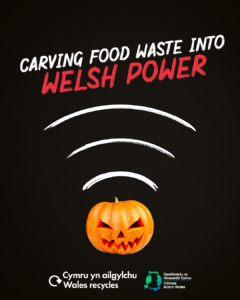We’re carving food waste into Welsh power this Halloween!
Spooky season is here, and as part of our continued support for the Wales Recycles Be Mighty. Recycle campaign that took place last week, we’re shining a spotlight on the plight of the pumpkin. Every year, so many of our poor pumpkins end up uneaten in the rubbish bin after they’ve lit up our doorsteps on 31 October – but did you know that recycling just one pumpkin skin would create enough energy to power a typical home for an hour? That’s a seriously scary amount of potential power being wasted!

Carving food waste into Welsh power this Halloween
We’re great at recycling here in Wales, being the world’s third best recyclers, but there’s even more we can be doing when it comes to saving food from the bin – and not just at Halloween! Most of us know that food waste should go in its own caddy, but a quarter of the average bin is still made up of food. This adds up to an enormous 110,000 tonnes a year, which is enough to fill 3,300 double decker buses! Astonishingly, most of this could have been eaten.
That’s why, this Halloween, we’re issuing a call to other Welsh residents to stop feeding their rubbish bins and follow these simple ideas instead…

Don’t waste those pumpkins after carving – make some delicious meals!
Eat everything that’s edible
There’s no need to feed the bin monster when there are so many ways to make sure everything gets eaten! Turn your Halloween pumpkin from a trick into a treat by transforming the edible parts into delicious dishes and desserts.
From American-inspired pumpkin pie to warming pumpkin risotto, there’s so much you can do to save your pumpkins from the bin. And those slimy seeds are just as precious – keep them for toasting and adding to granola or baking into tasty treats like these pumpkin seed brownies. Here are some more ideas for eating your Halloween pumpkins.
Of course, these ‘pumpkin principles’ also apply the rest of the year. Whether it’s tucking into what’s left of your Sunday roast for dinner the next day or turning those last few potatoes lurking at the back of the cupboard into some tasty loaded potato wedges for all the family to dig into, finding creative ways to use up food that’s nearing the end of its life is satisfying, delicious and money-saving!

Even our animals enjoy a pumpkin feast
Make the caddy your go-to bin for inedible food
Halloween is the one time of year when the grosser the food, the better. Lychee eyeballs, spaghetti worms, witches’ fingers – anything goes. But on the subject of gross food, we have the small matter of how to get rid of the stuff you can’t eat for whatever reason. From teabags to bones to eggshells and even mouldy food, it should all – no matter how yucky – go in the food waste caddy for recycling so that it can be turned into something useful: energy!
Sticking with the Halloween theme, recycling just one pumpkin skin could power a TV long enough to watch Hocus Pocus and the Addams Family. Recycling four banana peels would create enough energy to charge a tablet ready to fire up some Halloween recipes, while recycling five teabags would create enough to charge a smartphone so you can send out your Halloween party invitations. Even better, recycling one caddy full of food waste would create enough energy to power your home for an hour!
Watch this video for more on what happens to your food waste when it’s recycled:
[InsertVideo video=https://www.youtube.com/embed/hw-Uhq6Z3fs?si=8nFNKKJnhjhAkJHR]
Avoid ‘ych a fi’
Halloween or not, nobody likes spooky smells or scary spills. If you’re worried your food caddy could be a culprit, you might be surprised to learn that recycling your food waste actually creates fewer smells, and it’s more hygienic than putting it in the bin! The trick is to keep your caddy clean and fresh, empty it regularly, use a liner and avoid liquids. Gather the family around and watch Matt Pritchard’s top tips in the video below!
[InsertVideo video=https://www.youtube.com/embed/LZ3YUfabY5w?si=8JyIAlYpht87fKYI]
Here’s lots more on how to recycle food waste – find out how you can Be Mighty this Halloween, and let us know what you do with your pumpkins over on our social media channels!
By entering your postcode into the Recycling Locator tool, you can find out exactly what your local council accepts in their recycling collection – we’ll even tell you which bin or bag to put it in!
You can also check if you have a garden waste collection and find contact information for your council, just in case you have any queries about collection days or replacements bins.